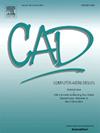AIXD:用于数据驱动和逆向设计的ai扩展设计工具箱
IF 3.1
3区 计算机科学
Q2 COMPUTER SCIENCE, SOFTWARE ENGINEERING
引用次数: 0
摘要
在建筑、土木工程或机械工程等许多学科中,设计过程涉及导航大型、高维和异构数据。虽然逆向设计和代理建模等人工智能驱动的方法可以增强设计探索,但复杂的工作流程以及对编码和机器学习专业知识的需求阻碍了它们的采用。为了解决这个问题,我们引入了AI- extended Design (AIXD):一个将AI集成到计算设计中的低代码、开源工具箱。AIXD简化了混合数据类型的处理,以及用于逆向设计、代理建模和敏感性分析的机器学习模型的分析、训练和部署,使领域专家能够用最少的编码快速探索各种解决方案。在本文中,我们展示了工具箱的功能,并演示了AIXD在建筑和工程设计应用程序中的功能,展示了它如何加速性能评估,生成高性能替代方案,并通过提供新的见解来改进设计理解。通过连接AI和设计实践,AIXD降低了数据驱动方法的入门门槛,使AI扩展设计更易于访问和高效。本文章由计算机程序翻译,如有差异,请以英文原文为准。
AIXD: AI-eXtended Design Toolbox for data-driven and inverse design
Design processes, in many disciplines like architecture, civil engineering or mechanical engineering, involve navigating large, high-dimensional and heterogeneous data. While AI-driven approaches like inverse design and surrogate modeling can enhance design exploration, their adoption is hindered by complex workflows and the need for coding and machine learning expertise. To address this, we introduce AI-eXtended Design (AIXD): a low-code, open-source toolbox that integrates AI into computational design. AIXD simplifies handling of mixed data types, as well as the analysis, training, and deployment of machine learning models for inverse design, surrogate modeling, and sensitivity analysis, enabling domain experts to rapidly explore diverse solutions with minimal coding. In this paper, we show the functionalities of the toolbox, and we demonstrate AIXD’s capabilities in architectural and engineering design applications, showing how it accelerates performance evaluation, generates high-performing alternatives, and improves design understanding by delivering new insights. By bridging AI and design practice, AIXD lowers the entry barrier to data-driven methods, making AI-extended design more accessible and efficient.
求助全文
通过发布文献求助,成功后即可免费获取论文全文。
去求助
来源期刊

Computer-Aided Design
工程技术-计算机:软件工程
CiteScore
5.50
自引率
4.70%
发文量
117
审稿时长
4.2 months
期刊介绍:
Computer-Aided Design is a leading international journal that provides academia and industry with key papers on research and developments in the application of computers to design.
Computer-Aided Design invites papers reporting new research, as well as novel or particularly significant applications, within a wide range of topics, spanning all stages of design process from concept creation to manufacture and beyond.
 求助内容:
求助内容: 应助结果提醒方式:
应助结果提醒方式:


